|
|
|

|
|
|
Of all the Indian wars, the Nez Perce war of 1877 may truly be the most
fascinating. The Nez Perce's first contact with whites was in
1805. Meriwether Lewis and William Clark were on their expedition
when they found the Nez Perce. The explorers found the Indian tribe ahead
of their time. They were highly skilled in selected horse breeding.
Lewis said they were "among the most amiable men we have seen.
Their character is placid and gentle, rarely moved into passion." |
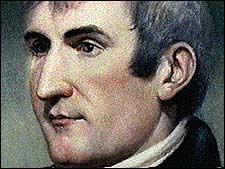
Meriwether
Lewis |
|
|
|
In 1836, the Reverend Henry Spalding built a mission
along the Lapwai Creek, which was in Nez Perce territory. There were
several bands of Nez Perce, all with different leaders and chiefs. One
particular band's leader was one of the Indians to be baptized at the mission in
1838. He was given the Christian name Joseph. His son,
Hin-mah-too-yah-lat-kekt, or Thunder Rolling Down the Mountain, was also
baptized and given the name Joseph. His father was often called Old
Joseph. The Nez Perce were a peaceful tribe of 3600 who lived scattered
between Oregon, Idaho, and Washington. They had been given their name by
French trappers for their pierced noses. "Pierced nose" in French was
"nez perce". They had become good cattle raisers and farmers
under the instruction of Reverend Spalding. Old Joseph's band was feeling
crowded by the white men, so Old Joseph moved his people to the Southern Nez
Perce domain, near the Wallowa Valley. This is why Old Joseph's band was
known as the Lower Nez Perce. |
|

|
|
In 1855 almost all the Nez Perce chiefs signed a treaty
which stated that all Nez Perces would move onto a 10,000 square mile
reservation. The government would give them $200,000 worth of goods in
compensation for the lands they lost. The new reservation would be near
the Lapwai Creek. It was called the Lapwai Reservation. Old Joseph's
band had occupied the Imnaha or Grande Ronde Valley in Oregon. It was the
best land in that part of the country. In 1860, there was a gold rush in
the Nez Perce country. The Nez Perce sold the prospectors horses and
cattle in hopes that they would go away. In 1863, the government changed
the size reservation from 10,000 to 1,000 square miles. Old Joseph refused
to move in anger. He tore up his bible, which he had called the "Book
of Heaven," and then he destroyed his American flag. Old Joseph's
health was failing, so he begged his son not to sign any more treaties. He
died in 1871 and Joseph the Younger became chief. |
|
|
|
In 1873 Chief Joseph got a federal order which stated
that white settlers would be removed from the Wallowa Valley and his
people would remain. The Nez Perce agent was having difficulty moving
them. The government saw what was happening, so they sent a threat from
General O.O. Howard in 1877 which said that a cavalry attack would force them
off their land, onto the reservation. Joseph said that he had made no
treaty to move. Since there was no treaty, Howard finally allowed Joseph
thirty days to gather his livestock. While Joseph was on a hunting trip,
some twenty warriors attacked a nearby settlement in retaliation. One
Indian had been killed. The leaders, even Joseph's brother Ollikut, were
determined to fight until the end. Joseph said, "I have tried to save
you from suffering and sorrow. Resistance means all of that. We are
few. They are many. You can see all that we have in a glance.
They have food and ammunition in abundance. We must suffer great hardship
and loss." Then Joseph began his plans for one of the greatest
military retreats in history. He planned to travel to Montana to join the
Sioux under their leader Sitting Bull. Joseph's first plan was to ambush
the army in White Bird Canyon. The army thought the Nez Perce would be
crossing the Salmon River, which they had no intention of doing. On
June17, 1877, they attacked the army, wounding and killing many. They
completely dominated. When losses were counted, the army found that
thirty-four soldiers had been killed, and only two Nez Perce had been wounded. |
|

|
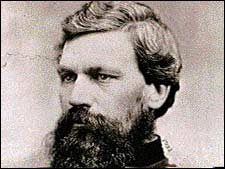
General Howard
|
So the Indians began their retreat, crossing the river,
and then some way ahead crossing again heading East. General Howard waited
six days for soldiers from other forts before pursuing the Nez Perce with 600
soldiers. By this time, the Nez Perce had a good head start. Colonel
Gibbons had orders from General Howard to cut them off at the end of the Lolo
Trail. They met, and Joseph sent a small party to distract Gibbons'
rear. Gibbons sent for help, and Joseph continued his retreat. Some
warriors fired at the camp at night and then stole some mules. They then
preceded onto Tash Pass, where they were supposed to be stopped by Lieutenant
Bacon, who let them go because he saw their large number and didn't want to
fight them. |
|
|
|
On July 6, Joseph's band was joined by the bands of
Looking Glass (who was called this because he wore a small mirror around his
neck) and Red Echo. They joined Joseph because they had heard of the
victorious battle at White Bird Canyon. On July 11, the Nez Perce were
surprised by the fire of a cannon and then a Gatling gun from General Howard's
forces. Tool-hool-hool-zote stopped the charge with twenty-four warriors
just long enough for Ollikut, Five Wounds, and Rainbow to join them with more
warriors. General Howard's troops were kept trapped until morning, and
then they charged into camp, taking little. This was known as the
Clearwater Battle. After it, Looking Glass was named war chief.
Since the Indians had been victorious up until this time, Joseph wanted to
return home and fight for their lands. But the other chiefs wanted to
travel Westward to form a military alliance with the Nez Perce's long time
allies, the Crows. Looking Glass was unanimously voted the person to lead
them there. |
|
|
|
Looking Glass took his time traveling, and all was
going well until August 8, when a Medicine Man named Pile of Clouds said,
"Death is on our trail." At dawn on August 9, 1877, General
Gibbons' men attacked. The Indians who came out of their tipis were shot
where they stood. Baby's heads were crushed with rifles or soldier's
boots. Looking Glass and White Bird ordered the Nez Perce to fight.
The soldiers began falling. At 8:00 a.m., General Gibbons called off the
battle, and his troops retreated to the woods. Twenty-nine soldiers were
dead. The Nez Perce had a tragic loss of eighty-nine, including chiefs Red
Echo, Five Wounds, and Rainbow. Mostly women and children had been
killed. Looking Glass was blamed for his slow marching and for resting in
the Big Hole Valley. On August 13, Howard began pursuing
again. By August 18, he was only a day behind. Ollikut and
twenty-eight warriors raided his camp, giving the Nez Perce three more days of
non-pursuit. The Nez Perce came in contact with the Crows, but they denied
helping because they had scouted for the U.S. Army and were frightened of its
power. The Nez Perce were stunned by the Crows, and had traveled over
1,000 miles. Their only hope now was to reach the Canadian border.
At Camus Creek, on August 20, the Indians stole 150 mules from
Howard. |
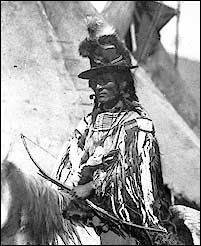
Looking Glass
|
|
|
|
On September 13, Colonel Sturgis caught up to
the Nez Perce and there was a small battle at Canyon Creek. On
September 29, the Nez Perce stopped in Bittersweet Valley near the Bear Paw
Mountains to rest and hunt for game. On September 30, the two Nez
Perce divisions held a council in one tipi since the two bands had camped a
little apart. They were to discuss sending riders ahead to find
exactly where Sitting Bull was. At 8:00 a.m., during the council,
General Miles attacked the camp. For the first time, Chief Joseph was
surprised. No soldiers had been spotted. In the first charge,
fifty-three of the 115 U.S. soldiers were killed. Joseph ordered some
young warriors to jump on the backs of some horses to save them. So
they rode across the Canadian border. At 1 p.m. there was a second
charge, and they fought until nightfall. One band had fled, and
Joseph's band had entrenched themselves from harm. Among the dead were
Tool-hool-hool-zote, and Joseph's brother Ollikut. On October 1, there
was a cold storm. An Indian woman described it, "Children cried
with hunger and cold. Old people suffering in silence. Misery
everywhere." Joseph and Looking Glass still clung to the hope
that the six trusted warriors that had ridden off had ridden off on the
horses had would reach Sitting Bull and the Sioux. They didn't know
that the warriors had been killed by hostile Assinboin Indians.
|
|

|
|
In the four months that the Nez Perce ran
from the army, never had a wounded warrior been left behind. Whenever
the Indians had come across whites trying to go past them, Joseph had always
graciously allowed them. The orders he gave the tribe about not
harming women or children were never disobeyed. In one instance,
he had even given some traveling white women horses. Now, after
traveling 1600 miles and within 40 miles of the border, Joseph
realized there was nothing to do but surrender. On October 4, Howard's
men got to the battle sight. Looking Glass, who thought it was Sitting
Bull coming to their aid, went outside the council tipi to see. He was
shot in the forehead instantly. On October 5, White Bird escaped to
Canada with 14 warriors with some women. Joseph surrendered out of
pity for his people, giving his rifle to Howard. The speech he
made will be remembered forever. Sadly, Joseph said these words:
|
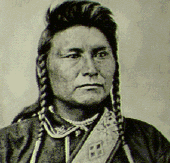
Chief Joseph
|
|
|
"I am tired of
fighting . . . . . It is cold and we have no blankets. The
little children are freezing to death. My people, some of
them, have run away to the hills and have no blankets, no
food. No one knows where they are- perhaps freezing to
death. I want to have time to look for my children and see how
many of them I can find. Maybe I shall find them among the
dead. Hear me, my chiefs. I am tired; my heart is sick
and sad. From where the sun now stands, I will fight no more
forever."
|
|
|
|
Only 431 Nez Perce remained from the original
700 who had escaped with Joseph. Only 79 of these were men. They
were to be sent to Fort Keogh, Montana, for the winter. Then
they were to be sent back to their reservation. Instead, they were
shipped to Fort Leavenworth, Kansas, place between a lagoon and the Missouri
River. Many died due to the health conditions. In 1879, Joseph
went to Washington D.C. to plead his case to U.S. President Rutherford B.
Hayes. But help was denied. In 1885, with the help of Bishops
Whipple and Hare, 150 of the Nez Perce, who chose to be Christians, were
sent back to the Lapwai Reservation. The rest, including Chief Joseph,
were moved to the Colville Reservation in Washington state.
|
|
|
|
In 1904, Joseph died, according to his
doctor, "of a broken heart." Joseph did not hate the whites,
and he never boasted of his accomplishments over them. He was an
excellent chief chief who had out-strategized some of the best military
minds the U. S. Army had to offer. Even General William Tecumseh
Sherman said of the Nez Perce, "the Indians throughout displayed a
courage that elicited universal praise . . . . [they] fought with
almost a scientific skill, using advance and rear guards, and field
fortifications." The Nez Perce retreat is known nation-wide for
its tragedy and its bravery. It will be remembered for generations to
come.
|
|
|
"The Great Spirit puts
it in the heart and head of a man to know how to defend
himself."
-Chief Joseph
|
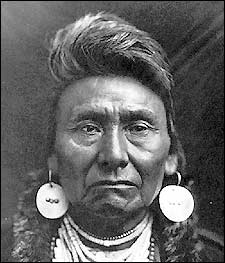
Chief Joseph
|
|

|
|
Ashley
Heptig
8th
American History
Rossville
Junior High
Plains
History Project
2004
|
Bibliography |
|
|
Revised: December 23, 2004
. |
![]()








![]()